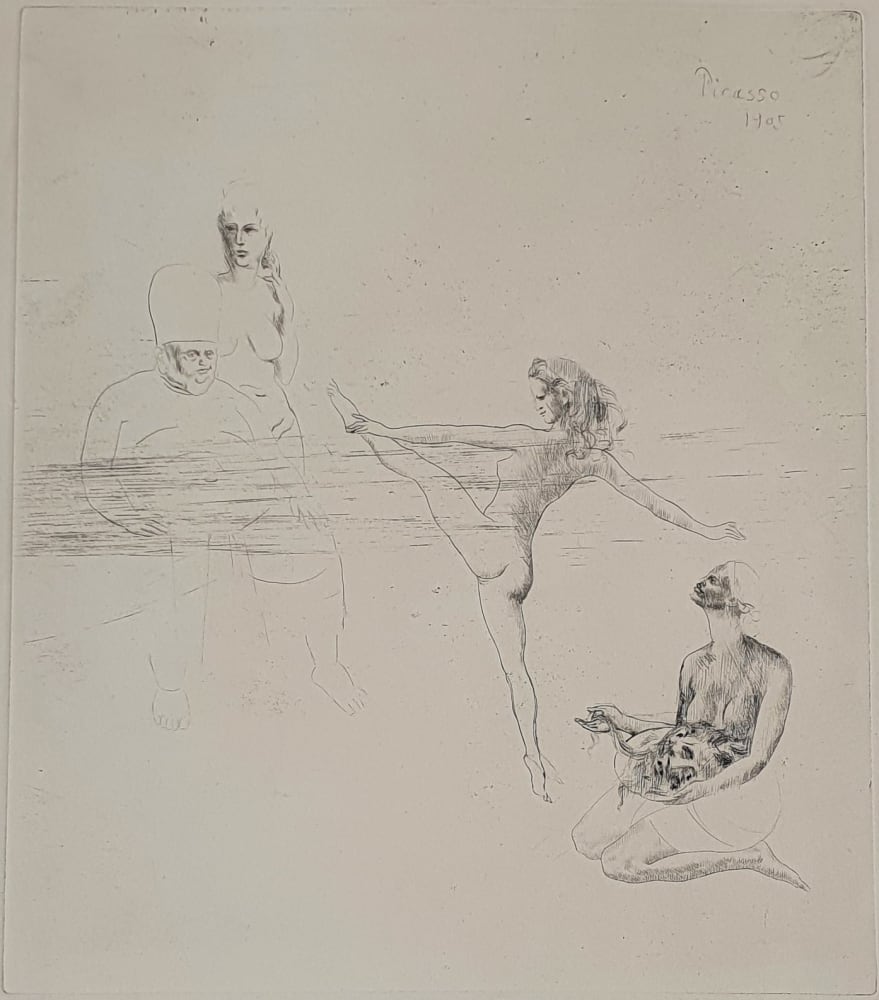Pablo Picasso
sheet size: 64 x 49 cm.
CHF 18'500 + taxes
The Salomé story was a favorite subject of French art and literature in the latter half of the nineteenth century, although why Picasso included it as part of the Saltimbanques series is something of a mystery. Both Picasso and Apollinaire boldly reimagined the biblical tale, interpreting it in their own distinctive ways. Apollinaire’s poem, also titled Salomé, appeared in Vers et Prose (which was edited by their mutual friend André Salmon) in the same year as the etching. This connection has led Richardson to surmise that the Suite des Saltimbanques may have been originally intended to illustrate Apollinaire’s poem: "The Salomé drypoint echoes the mocking mood of Apollinaire’s lines on the same subject: ‘Weep not, pretty jester to the king /Take this head instead of cap and bells and dance’" (John Richardson, A Life of Picasso: The Prodigy, 1881-1906, New York, NY, 2007, p. 334.)
Regardless of his intention, Picasso’s etching reveals an early propensity for sexual subjects in his prints, a proclivity that would become more apparent as he matured. Salomé is shockingly nude (she is traditionally depicted in several layers of jewels and veils), kicking her leg into the air and fully exposing herself to her stepfather Herod, who seems to be looking at the viewer with a wry smile on his face. Behind him, Salomé’s mother Herodias, who had asked her daughter to dance for her husband in order to trick him into ordering the execution of John the Baptist (whom she loved), averts her eyes. Her position ‘over’ Herod, but hiding behind him, implies the power imbalance in the exchange, as well as Herod’s ignorance of her machinations. Below, in an anachronous vignette, a servant watches the dance while holding the prophet’s head on a platter. The plump figure representing Herod appears several times within Picasso’s paintings, drawings, watercolors, and prints of the period and was modeled after a saltimbanque Picasso befriended. Whilst Salomé is unrelated to the wider theme of the suite it shares the sparse composition and delicately lined figures of other plates in the series. In particular, Salomé’s graceful and weightless form shares characteristics with the female acrobats on horseback in Au Cirque (Bloch 9). The lines that run across the middle of the composition from the left to the right center are a result of Picasso’s use of a previously etched plate, a common practice for him during his early years of poverty. However, they have the added effect of focusing attention on the girl’s provocative gesture.
This particular impression is one of a very small number printed by Eugene Delâtre in 1905 before the copper plate was steel-faced. Only these early impressions retain the full richness of the drypoint burr, particularly noticeable in the Saint’s head, the figure of the servant, and the outline of Salomé. It is unusual also in being signed by the artist.
Provenance
James H. Clark, Dallas.Anon. sale, Kornfeld und Klipstein, Bern, 20 June 1970, lot 44.
Anon. sale, Kornfeld und Klipstein, Bern, 14 June 1974, lot 841.
Acquired from the above by the present owner.
Exhibitions
Chicago, R.S. Johnson International, Pablo Picasso, Master of Graphic Art, 1984.
Museu Picasso, Picasso and Caricature, January-April 2003.
The Art Institute of Chicago, Graphic Modernism: Selections from the Francey and Dr. Martin L. Gecht Collection at The Art Institute of Chicago, November 2003-January 2004.
Basel Social Club, 2025
Literature
G. Bloch, Catalogue de l'oeuvre gravé et lithographié 1904-1967, Bern, 1968, p. 13, no. 14 (another example illustrated).B. Baer, Picasso Peintre-Graveur, Bern, 1986, vol. I, p. 43, no. 17 (another example illustrated).
